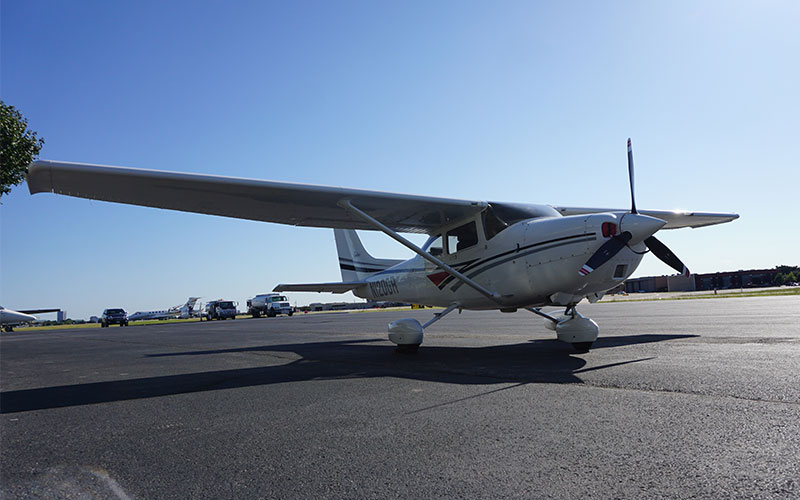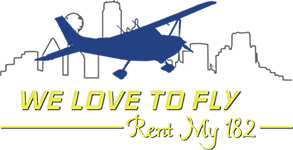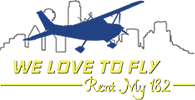SPECS
Year: 1999
Make/Model: CESSNA 182S SKYLANE
Registration: N120GR
Total Time as of Sept 2017: 3,658
Condition: Used
Flight Rules: IFR
Engine 1 overhaul Time since Sept. 2017: 1,710 SFOH
Year Painted: 1999
# of Seats: 4
Engine 1 overhaul Time since Sept. 2017: 1,710 SFOH
Year Painted: 1999
# of Seats: 4
CURRENT RATES
Dry Rate: $150.00
Fuel Rates: approx $55-60/hr (for 13 gallons)
Fuel costs @ Atlantic as of Oct 2017

DESCRIPTION
1999 Cessna 182S Skylane, 3658TTAF, 1710SFOH, 2 – KX 155A Nav/Comm w/Glideslope, KLN 89B IFR GPS, KT 76C Mode C Transponder, KAP 140 Dual Axis AP, KR 87 ADF, Avidyne MFD, new Reiff Turbo XP Engine Heater, All AD’s Complied with, and Complete Logbooks.
AVIONICS/EQUIPMENT
AVIONICS:
KX 155A Nav/Com with Glideslope KX 155A Nav/Com
Kl 209A VOR/LOC/GS Indicator with GPS Interface
Kl 208 VOR/LOC Indicator KMA26 4 Place Audio Panel KT 76C Mode C Transponder KLN 89B GPS – IFR Certified KR 87 ADF System
KAP 140 Two Axis Autopilot with Electric Trim Avidyne MFD
EQUIPMENT
(2) BOSE A20 head sets
(2) David Clark head sets
Step and Grab Handles Cabin Fire Extinguisher Electric Trim
Dual Vacuum Pumps Avionics Cooling Fan JPI Engine Monitor Co Pilot Push to Talk
Pilot and Co Pilot Vertically Adjusting Seats All Logbooks
ADDITIONAL EQUIPMENT
Reiff Turbo XP Engine Heater Wheel Fairings
AIRFRAME
3658 Hours Total Time as of sept 2017
ENGINES/MODS/PROP
ENGINE
Lycom ing 10 – 540 AB1A5 230HP
1,710 Hours Since Factory Overhaul
PROP
McCauley 3 blade prop –
10 Hours Since Prop Overhaul
INTERIOR & EXTERIOR PHOTOS
N120GR STANDARD OPERATING PROCEDURE CHECK LIST
N120GR Standard Operating Procedure check list:N120GR Standard Operating Procedure check list:
Hello, thanks for flying my 1999 C182S model today/tonight. PLEASE adhere to the following few brief requests regarding flight operations so that we may all help to continue to maintain this airplane in the great condition I recently bought it in! IF, at any point you experience any issue/squawk/question PLEASE call (owner David Snell at 469-767-2645) PLEASE treat this airplane as if it is your own so that we may continue to ALL enjoy flying this airplane.
- Check fuel/oil prior to each flight! OIL at a MIN will be 6 quarts. IF oil is needed, oil/funnel/paper towels found in cargo area. PLEASE be careful to not get oil on engine/or on plane interior… check hands carefully!!!
- DOOR CLOSURES: PLEASE make sure ALL PILOTS ensure they shut both….passenger doors for guest and obviously your own! Easiest to “open window” and pull shut with two fingers (pilot window) as for passenger, make sure………the inside door handle is in correct UPRIGHT position and that the DOOR DEAD BOLT is NOT extended where it can hit striker plate! Then barely pull door shut where it closes, then press inside door latch forward/down in place. IF done correctly doors almost will close on their own. Please NO slamming door and please make sure the DOOR BOLT LOCK does NOT get “deployed” and you slam door with it extended as if it hits striker plate can be very costly to fix! ALSO please DO NOT let wind slam doors!
- FIRST FLIGHT of the day/night start up procedure. COWL FLAPS OPEN! Follow check list for regular prime/start BUT if plane is cold and hasn’t flown prior. I prime to about 4lbs then leave mixture rich…throttle cracked open, should fire up, IDLE 750 ish please during warm up! Please allow it to run several minutes upon starting until you see oil temp come up to bottom of green arc! LEAN IT OUT ON GROUND/TAXI!!! It is imperative we lean it out pulling red mixture handle out till you get slight rough noise then twist in. Pull (TWIST) handle out about 1.5 to almost 2 inches during ground ops please! FULL rich during run up though! May want to burn 30 minutes on LFT side if tanks are full then back to both! Rt side seems to burn slightly faster than lft.
- DURING INITIAL climb out once 500 ft AGL pull throttle (GENTLY) back to about 24 hundred RPMS……..and roll prop pull back slightly BUT NOT BELOW the RPM setting please! Climb out around 85-95 ish which may keep cylinder head temps down UNDER 380 0r around 380 F. NEVER NEVER “chop/drop” always SLOWLY retard throttle watching CHT temps do NOT drop too fast etc! You can shock cool cylinders that way!
- CRUISE SETTINGS at altitude: COWL FLAPS closed. Probably 21/22 rpms and 23/24 ish on manifold pressure on a cross country flight. TOUR FLIGHTS may require we play with settings to slow it down BUT MUST WATCH CHT on small gauge right side of panel. Lean to about 13 gallons an hour SHOULD keep cylinder head temps UNDER 400 ideal sweet spot 380 ish please. TOUR FLIGHT SETTINGS: 19 man press and 2300 rpms
- Decent: PLAN AHEAD! Start down early! DO NOT chop/drop the throttle as a sudden reduction in power can/will “shock cool” the cylinders and that destroys them faster than anything! SLOWLY retard power and bring fuel in watching the CHT gauge to slowly bring everything down for landing! Please do NOT just pull throttle back on final or base to final etc. Plan ahead start early! NEVER pull throttle back in a hurry please!!
- LANDING: TRIM TRIM TRIM NOSE UP! This is a NOSE HEAVY plane (it will drop when you reduce power) and it is wise to trim it UP to where you have a slight positive back pressure as you retard throttle as you will feel nose want to drop. NEVER land on nose wheel please “feel” your way down glide path! Please adjust trim wheel back to take off position…….. once down and off run way etc. THEN LEAN again during ground taxi please! It will help to eliminate fouled plugs! LONG roll out to stop NO HARD braking!
- PUT plane up: Shut off radio master/ MASTER itself, gust lock in, record times in binder found in cargo area of airplane please! Get it topped off IF below ONE THIRD LEFT in tanks. 88 useable full so when you get around 30 gallons left have ATLANTIC top it off! CLEANING AFTER FLIGHT PLEASE: Please use water spray bottle or Meguires detail spray and terry towel or paper towels and wipe down leading edges of wings/horizontal stab/wing struts for bug removal! USE ONLY specially marked foaming windshield foam for wind screen/windows! Throw away all trash from plane/flight………..place terry towels in receptacle in cargo area or take home wash!
- ASK Atlantic to put plane back in hangar….CALL or TEXT David Snell at 469-767-2645 to let me know you made it down and airplane performed ok when you got in it and when you were done! IF any issue……..comes up I want to know about it ASAP pre OR post flight so I can get it addressed!!
Thanks for adhering to these few additional operating procedures I would like all of us me included to follow while flying N120GR. IF we do…we should continue to have a great 1999 C182 aircraft to enjoy with minimal issues/problems. Treat it like it’s your own please!!! Thank you, David Snell cell 469-767-2645

